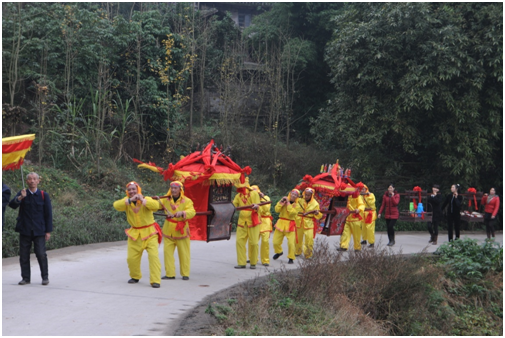 Bridging News
Bridging News
Audible | Tanghe Marriage Customs
Editor's Note: This article is produced in collaboration with the Chongqing Institute of Foreign Studies as part of a series of ongoing reports exploring the city's abundant resources in intangible cultural heritages.

Tanghe Marriage Customs.
In May 2007, Tanghe Marriage Customs were inscribed in the first batch of Chongqing’s intangible cultural heritage protection projects and are now being declared for the third batch of national intangible cultural heritage protection projects. According to the Local Chronicles of Tanghe, Tanghe Marriage Customs originated in the Song Dynasty (960-1279) and flourished in the Ming Dynasty (1368-1644). With grand scenes and intricate etiquette, they are the epitomes of ancient wedding culture in southwest China, a mixture of the wedding characteristics of Guizhou, Sichuan, and Chongqing.
Under the impact of urban modernization, traditional marriage customs have fallen behind the needs of modern society. Faced with the threat of dying out, Tanghe Wedding Customs is no exception. Fortunately, having realized the importance of traditional marriage customs, the inheritors manage to integrate traditional culture with modern society in their continued efforts, thus making the custom’s preservation and social recognition possible.
Tanghe Marriage Customs includes as many as thirteen procedures, each featuring mixed various traditions, strong local color, and diverse cultural connotations. From pre-wedding preparation to the bride's return to her parent's house on the third day after the wedding ceremony, each process involves a host of details, among which wedding lament is the most quintessential.
Wedding lament is a bride's cry of farewell to her family before getting on her wedding sedan chair. On the night before the wedding ceremony, the bride’s family throws a feast, and the bride burns joss money to her ancestors, informing them of her forthcoming marriage. The next morning, the bride leaves her parents. During this whole period, the bride tears to her relatives one by one.
As a rite, a wedding lament is not a simple cry. Rather, it is one with particular tonal patterns and rhyme schemes, whose singing tunes and lines vary from person to person. It not only voices the bride’s reluctance to part with her family and confusion about the new family but also represents her gratitude to relatives and friends, her maturity and independence, and her longing and expectations for future life.
The local government has made a series of efforts to conserve Tanghe Wedding Customs, including but not limited to hosting relevant cultural activities and advertising these customs on radio and television to draw public attention. Chongqing Intangible Cultural Heritage List records that the government of Jiangjin District and Tanghe Town began to collect information about Tanghe Marriage Customs in 2004 and set up a protection and inheritance office along with a 278-square-meter exhibition hall in 2006. In the same year, Jiangjin TV Station shot a documentary on Tanghe Marriage Customs, aiming to publicize them via media to attract tourists from all over.
Moreover, the government has ordered the protection of existing tools used in Tanghe weddings, ranging from bridal sedan chairs, dou, sieves, and gongs to gift boxes. It has also issued a notice on the measures to inherit and protect "Tanghe Marriage Customs," which stipulates that a certain amount of grant, a free bridal sedan chair, and a free wedding MC are to be offered to couples who wed in accordance with Tanghe Wedding Customs.
These measures are designed to promote the inheritance and revival of the Tanghe marriage culture. Meanwhile, local residents can better experience local culture and marriage services.
Chinese script: He Yina
Tutored by: Huang Xiying
Translation: Wu Liang
Tutored by: Tu Qingqing Wu Shulin Hu Wei
Voice-over: Wang Jinxuan
Tutored by: Chen Juan
 Related Stories
Related Stories